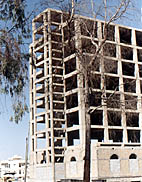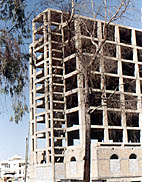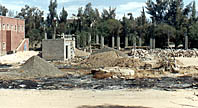
The Construction Industry: MEETING NEW CHALLENGES [Archives:1999/03/Business & Economy]
January 18 1999
Introduction:
The construction business in Yemeni witnessed a lot of progress over the last three decades, but notably since Yemen’s reunification on May 22nd 1990. The aimlessly sprawling urban centers is a visible proof to this development. However, one of the main obstacles contractors still face is how to reduce high costs, especially of skilled workers and material used in applying traditional design and architecture in new buildings.

As a result, traditional Yemeni architecture became popular among investors. Unfortunately, however, the cost of construction along the traditional lines of architecture is much higher than the modern cement blocks. That is why architectural engineers have devised a new design which combines old and new ways in construction.
Construction Material:
Yemen is well-endowed with traditional and modern construction material. Except for iron/steel bars and some wooden components, most of the other material is local. This includes the colored stones, bricks, flagstones, cement, cement blocks, sand, gravel, wooden panels, sewerage pipelines, plastic tubes, etc.
Stones are cut out from mountain sides in huge quarrying pits which dot the landscape of Yemen. Rocks in all kinds of density, strength and colors are available. The colors include red, green, yellow, beige, blue, black, white, etc. Rocks are trucked to the construction sites by large lorries.
Imported steel plates and bars are twisted and shaped in various ways giving strength and beauty. The skills of Yemeni iron-smiths and welders go back deep into history. It will be remembered that Yemen produced a large share of the swords, shields, arrows, and spears of the Islamic armies that over-ran most the Old World a millenium and a half ago.
The gypsum used in construction is a unique Yemeni variety called ‘gos’. Yemenis males fantastic shapes or arcs, loops, curves, and of course, the famous qamariyas (glass-windows) from this material.
Today, there are three cement plants in the country. These are at Amran (Sanaa), Bajil (Hodeidah) and Mafraq (Taiz). Given the rising level of demand and the resultant gap in supply – now covered through imports, there are plans to build more cement plants in the country.

There are 5 major kinds of stones known by Yemenis and all local architects. They are categorized first, as Igneous rocks (Rock fragments) of volcanic tuffs (Ashes), its formula contains Pyroxen + Plasioclase and have the following peculiarities:
1. (a) The Black Abyssinian stone: is known as Vesicular Basalt, and found almost in all areas.
(b) The Deluxe stone: is known as Basalt, and found in Dhamar
2. The Red Stones: yHigh rate of pure iron is found in Rada’a.
3.The Beige (Grayish tan) stone: High rate of Aluminum is found in ‘Abasser mountain.
4.The White stone: High rate of Aluminum is found in Sa’adah.
5.The (extra-light) Green stone: High rate of Andesine is found in Manakha.
Furthermore, Granite, which is formed of Quartz, Orthoclase and Hornbland is used in buildings.
Secondly, Sedimentary Rocks such as Limestone Ca CO3, and Sandstone formed by Quartz particles are good for construction.
Thirdly, a Metamorphic Rock such as Gneiss formed of Quartz, Orthoclase and Mica are good materials for building purposes.
Finally, many Geologists think that the chemical formula of substances in nature give color, shape, and masses, of all various rocks and soil in Yemen.
Contractors:
Yemenis have long been in the construction business. The huge ancient dams, the mountain-side terraces, the tall buildings and other monuments are standing testimony to a ‘Nation of Builders’ as Yemenis have been dubbed.
Thus has been organized through different-size contracting firms and companies. The majority of these are small, and they are organized along family lines. This means a few relatives get together to form a small team. It also means that the contractors work along specialized lines – masons, plasterers, carpenters, electricians, etc.
Then there are the medium-size companies which can take full responsibility for the whole construction project. Most Yemenis who plan to build a home approach this group of contractors.
Finally, there are the large construction companies. These are multi-purpose construction companies which own lots of equipment such as cranes, mixers, trucks, etc. These companies also invest on their own in constructing residential and office complexes which are then sold over to the public.
The country has also seen the arrival of foreign construction companies. The most famous is Consolidated Construction (International) Company, known more as CCC. This company’s origin dates back to Aden in the late 1940s. Other companies include Chinese, Korean and others.
Prices:
Prices of construction material are usually among the most volatile in the country. Even during periods of economic stagnation, construction is one of the least affected fields. The reason is simple. A rapid population growth pushes demand for housing constantly.
One of the problems of the construction industry is bottlenecks in supply. This is especially true of cement, which is often stocked by greedy merchants while awaiting a steep price rise. I have given in the adjacent table some representative price levels of the main construction material and labor.

Good Investment:
Yemenis have always felt that real estate is one of the most secure investments. Besides, nobody ever remembers any time when the value of real estate has drastically come down, although it is happening at this moment.
Most people who have extra resources, especially in cities, have invested in the construction of lavish dwellings or villas. These were oriented towards foreigners. Since the mid-1980s and until only a few years back, demand for spacious and well-built residential and office buildings has been high. Foreign companies, embassies, international organizations, consultants and experts have all paid handsomely for good homes and offices.
As a result, many large and spacious villas were built, especially in the capital city, Sanaa. Today, many of these stand empty as many foreigners either left the country, or foreign influx has subsided.
Ironically, demand for midium and small size houses and apartments continues to grow. This demand is mostly generated by Yemenis who have come from the countryside or from abroad. Thus is there is excess demand for one group of housing, and there is excess supply for another group of housing.
Conclusion:
The Yemeni government can help spur construction of homes if it were to uphold the law on real estate ownership. Many would-be investors are frustrated nby this problem.
The government must encourage small-scale housing projects by applying variable taxes. This will entice private projects that is small in size.
By: Ghassan Al-Ahdal,
Yemen Times
——
[archive-e:03-v:1999-y:1999-d:1999-01-18-p:./1999/iss03/b&e.htm]


